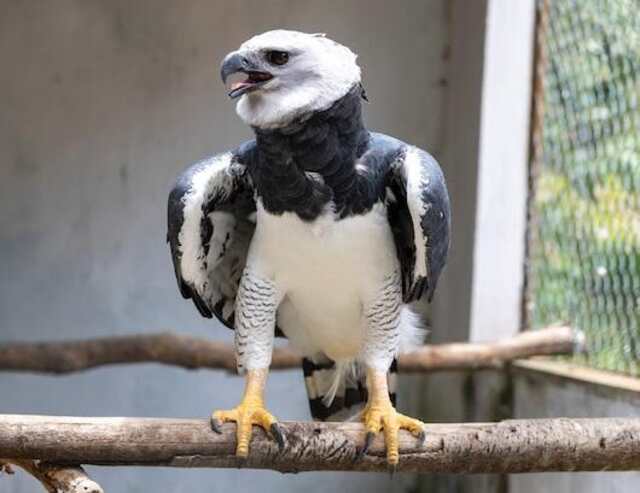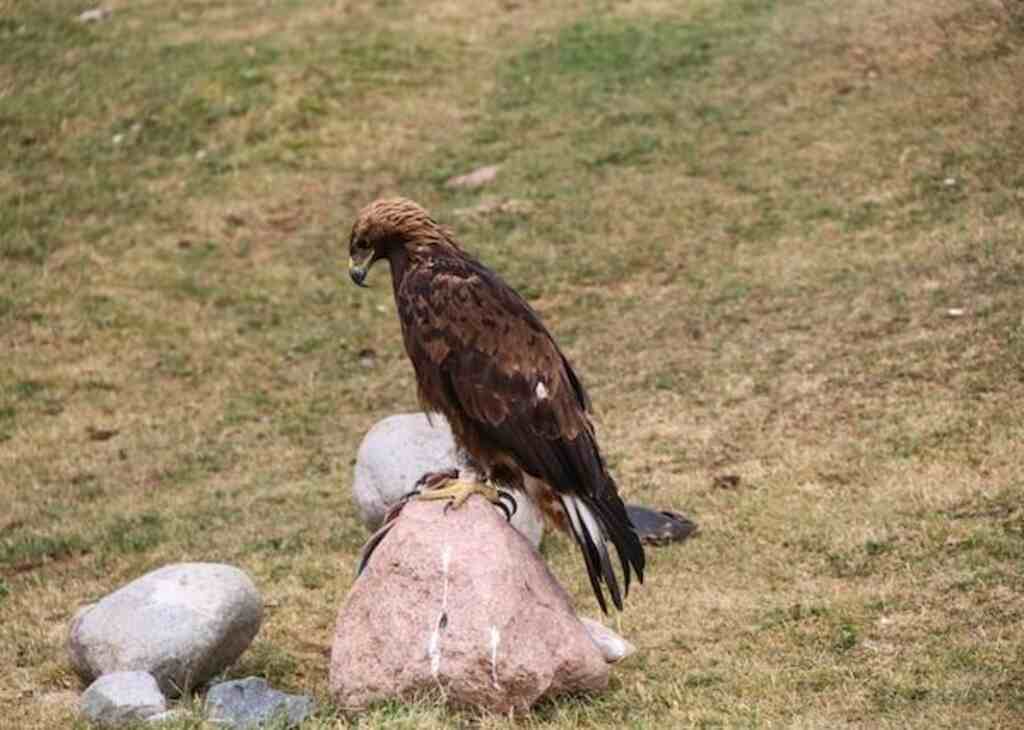Do Eagles Eat Squirrels? Eagles, majestic creatures of the sky, have long captivated the imagination of nature enthusiasts and researchers alike.
Their diet, a subject of fascination and curiosity, encompasses a wide range of prey. Among the various potential food sources that eagle’s target, squirrels hold a particular interest.
Join us on this scientific exploration as we delve into the fascinating relationship between eagles and squirrels, revealing the hidden complexities that shape our natural world.
Get ready for jaw-dropping tales of aerial acrobatics and surprising squirrel escapades!
Table of Contents
- 1 Key Takeaways
- 2 Overview of Eagle’s Diet
- 3 Eagle’s Hunting Techniques
- 4 Prey Preference Based on Size and Habitat
- 5 Availability of Squirrels in Eagle’s Habitat
- 6 Examples of Prey commonly targeted by Eagles
- 7 Squirrel’s Defense Mechanisms against Predators
- 8 Do Eagles Eat Squirrels
- 9 Instances of Eagles hunting and consuming Squirrels
- 10 Factors influencing Eagle’s Diet Choices
- 11 Role of Squirrels in the Food Chain
- 12 Frequently Asked Questions
- 13 Conclusion
- 14 Author
Key Takeaways
- Eagles have a diverse diet that includes squirrels, fish, reptiles, amphibians, and birds.
- Squirrels are a common choice for eagles due to their presence in forested habitats.
- Changes in squirrel populations can impact the success of eagle foraging strategies and the overall ecosystem.
- Eagle-squirrel interactions have been studied due to their impact on both species and the importance of understanding eagle’s diet choices for conservation efforts.

Overview of Eagle’s Diet
Eagles primarily consume a variety of prey, including small mammals such as squirrels. The eagle’s diet is characterized by its adaptability, as it can feed on a wide range of animals depending on availability and habitat conditions.
While small mammals like squirrels are a common choice, eagles also target fish, reptiles, amphibians, and even birds.
The eagle’s mating behavior plays a crucial role in its diet, as pairs work together to secure and defend territories that provide sufficient food resources for their offspring.
Furthermore, climate change has the potential to impact the eagle’s food sources, as it can disrupt the availability of prey and alter the ecology of their habitats.
Despite these challenges, eagles have evolved various hunting techniques, such as aerial diving, stalking, and ambush, to ensure their survival and successful predation.
Eagle’s Hunting Techniques
With their keen eyesight and remarkable agility, these majestic predators employ hunting techniques akin to a skilled archer drawing back a bowstring, swiftly capturing their prey in a seamless motion.
Eagles have developed a diverse array of hunting strategies that enable them to effectively target a wide range of prey.
They are known for their aerial hunting prowess, often soaring high above their hunting grounds and scanning the terrain below for potential targets.
Once they spot their prey, eagles dive at astonishing speeds, utilizing their powerful talons to seize their victims.
This predation can help maintain a healthy balance in ecosystems, preventing overpopulation of certain species.
Transitioning into the next section about prey preference based on size and habitat, it is important to understand how the eagle’s hunting techniques shape their dietary choices.
Prey Preference Based on Size and Habitat
The prey preference of eagles is influenced by factors such as size and habitat, shaping their dietary choices and ultimately contributing to the ecological balance within their ecosystems.
Eagles exhibit a diverse range of hunting techniques that allow them to target a variety of prey species.
When it comes to squirrels, eagles have been observed to primarily prey on them due to their abundance in many ecosystems.
Squirrels are small to medium-sized mammals, making them suitable prey for eagles of various sizes.
Furthermore, squirrels are commonly found in forested habitats, which are preferred by eagles for nesting and hunting.
This overlap in habitat increases the chances of encounters between squirrels and eagles, leading to an increased squirrel predation rate.
Understanding the prey preference of eagles, particularly their predation on squirrels, is crucial for assessing the squirrel population dynamics and the overall functioning of the eagle’s habitat.
Transitioning to the subsequent section, the availability of squirrels in the eagle’s habitat plays a crucial role in determining the success of their foraging strategies.
Availability of Squirrels in Eagle’s Habitat
The abundance of squirrels in the eagle’s habitat significantly impacts the success of their foraging strategies and influences the dynamics of their ecosystem.
The squirrel population dynamics play a crucial role in determining the availability of this prey for eagles.
Factors such as habitat loss can have a direct impact on squirrel abundance, affecting the eagles’ ability to find and capture squirrels.
Research has shown that eagles tend to prefer areas with higher squirrel densities, as it increases their hunting success rate.
Squirrels are an important food source for eagles due to their abundance in certain habitats.
The availability of squirrels influences the distribution and behavior of eagles within their habitat.
Changes in squirrel populations can have cascading effects on the entire ecosystem, as eagles may seek alternative prey when squirrels are scarce.
Understanding the relationship between squirrels and eagles is essential for conservation efforts and maintaining the balance of ecosystems.
Examples of prey commonly targeted by eagles will be discussed in the subsequent section.

Examples of Prey commonly targeted by Eagles
Examples of prey commonly targeted by eagles include small mammals such as rodents and hares, as well as birds of various sizes and species. Eagles are opportunistic hunters and adapt their hunting strategies based on the behavior of their prey.
In the case of squirrels, eagles have been observed utilizing different tactics to capture them.
Some eagles employ ambush hunting strategies, waiting patiently on high perches and swooping down to snatch squirrels when they are least expecting it.
Others may engage in aerial pursuits, chasing the squirrels through the trees and using their speed and agility to their advantage.
The squirrels’ defense mechanisms against predators will be discussed in the subsequent section.
Squirrel’s Defense Mechanisms against Predators
Squirrel’s defense mechanisms against predators include:
- A high-pitched alarm call that can be heard up to 300 feet away, allowing other squirrels in the area to take cover. This evolutionary adaptation helps to alert nearby individuals of the potential danger, increasing the chances of survival for the group.
- Quick reflexes and agility, allowing them to swiftly move between trees and escape from predators.
- Excellent climbing skills that enable them to seek refuge in higher branches where larger predators like eagles might struggle to reach.
- A keen sense of hearing and vision, enabling them to detect potential threats from a distance.
These predator-prey dynamics have shaped the squirrel’s ability to defend itself against various predators, including eagles. With these defense mechanisms in place, squirrels can often evade eagle attacks and survive in their natural habitats.
Instances of eagles hunting and consuming squirrels will be discussed in the subsequent section.
Do Eagles Eat Squirrels
Yes, eagles do eat squirrels. Squirrels are among the prey that eagles target in their diverse diet. Eagles employ various hunting techniques and adapt their strategies to capture squirrels.
Understanding this predator-prey relationship sheds light on the ecological dynamics of these remarkable birds and their role in the food chain.
Instances of Eagles hunting and consuming Squirrels
Instances of raptors, such as eagles, preying on squirrels are frequently observed in the natural world. Eagle-squirrel interactions have been the subject of study due to their impact on both species.
Eagles are opportunistic hunters and have been known to target squirrels as a food source.
The abundance of squirrels in an area can influence eagle behavior, as they may adjust their foraging strategies to exploit this resource.
Eagles have been observed hunting squirrels both on the ground and in trees, using their keen vision and powerful talons to capture and kill their prey.
This predatory behavior plays a role in regulating squirrel populations and maintaining a balance in the ecosystem.
Understanding the factors influencing eagle’s diet choices, such as the availability and distribution of squirrels, is important for comprehending the dynamics of predator-prey relationships in natural communities.

Factors influencing Eagle’s Diet Choices
One key factor influencing the dietary choices of eagles is the availability and distribution of their preferred prey, which can shape their foraging strategies and hunting behavior.
Factors influencing hunting include the abundance and accessibility of prey, as well as competition from other predators.
Eagles are opportunistic hunters and will adjust their diet based on the availability of food sources.
The impact of these factors on the ecosystem is significant, as eagles play a crucial role in maintaining the balance of the food chain.
By preying on smaller animals such as squirrels, eagles help control their populations, preventing them from becoming overabundant and causing negative effects on vegetation and other species.
Understanding the factors that influence eagle’s diet choices is essential for studying and conserving these magnificent birds.
Transitioning into the subsequent section about the role of squirrels in the food chain, it is important to examine their relationship with other organisms.
Role of Squirrels in the Food Chain
Squirrels play a vital role in the food chain, contributing to the overall biodiversity and health of ecosystems. Their presence has several impacts on other species and the ecosystem as a whole.
- Seed dispersal: Squirrels are important seed dispersers, as they bury and store acorns and other nuts for later consumption. This behavior helps in the dispersal and germination of plants, aiding in the growth and regeneration of forests.
- Predation control: Squirrels are prey for a variety of predators, including birds of prey like eagles. Their population size can influence the availability of prey for these predators, affecting their survival and reproduction.
- Nutrient cycling: Squirrels consume a diverse range of plant material, including fruits, seeds, and foliage. Through digestion and excretion, they contribute to the recycling of nutrients back into the soil, promoting nutrient availability for other organisms.
- Habitat modification: Squirrels create burrows and nests in trees, which can provide shelter and nesting sites for other species, such as birds or insects.
Overall, squirrels have a significant impact on the ecosystem, influencing the distribution of plants, the availability of prey for predators, and the structure of habitats.

Frequently Asked Questions
How long do eagles typically live in the wild?
Eagles in the wild typically have a lifespan of around 20 to 30 years. The eagle population relies on suitable eagle nest sites for successful reproduction and survival, highlighting the importance of maintaining and protecting these habitats for their long-term survival.
What is the average wingspan of an eagle?
The average wingspan of an eagle is approximately [insert average wingspan]. Eagles have a lifespan of [insert eagle lifespan]. These measurements are based on scientific research and provide objective information on the physical characteristics and lifespan of eagles.
How many species of eagles are there worldwide?
There are approximately 60 species of eagles worldwide. Conservation efforts focus on protecting endangered eagle species, while eagles hold cultural significance in various countries. Scientific research and global collaboration are crucial for their preservation.
Do eagles migrate during certain times of the year?
Eagles exhibit migratory behavior during certain times of the year. This behavior is influenced by a variety of factors, including seasonal changes, availability of food, and nesting requirements. Eagles typically migrate to different habitats to ensure their survival and reproductive success.
Can eagles eat other types of small mammals besides squirrels?
Eagles, known for their diverse hunting habits, have a wide range of prey preferences. They are capable of feeding on various small mammals in addition to squirrels, showcasing their adaptability as predators.

Conclusion
In conclusion, eagles have a diverse diet that includes a variety of prey, such as squirrels. They employ various hunting techniques and display a preference for prey based on size and habitat.
Squirrels are commonly found in the habitat of eagles, making them a potential target for predation.
However, squirrels have defense mechanisms to protect themselves from predators. Despite this, there are instances where eagles successfully hunt and consume squirrels.
Factors such as availability of prey and competition for resources influence the dietary choices of eagles. Squirrels play a significant role in the food chain, serving as a prey species for eagles and other predators.
As the saying goes, ‘In the eagle’s world, the squirrel is a fleeting prize.’



